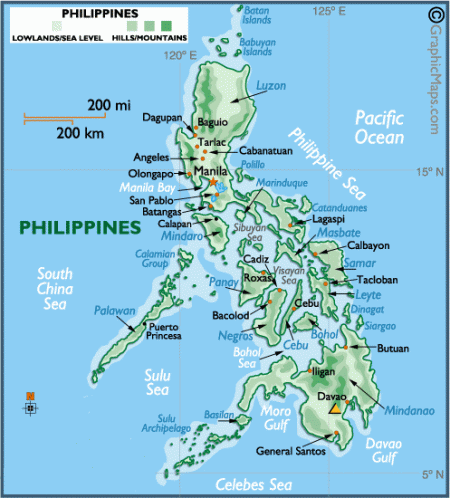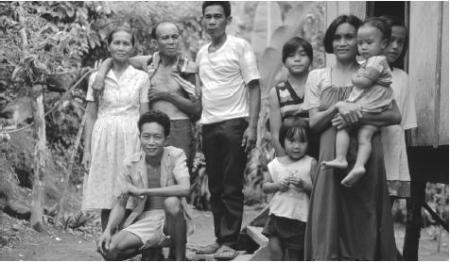PHILIPPINES CULTURE
Philippines National Anthem (English Version):
Philippine cuisine:


two equal horizontal bands of blue (top; representing peace and justice) and red (representing courage); a white equilateral triangle based on the hoist side represents equality; the center of the triangle displays a yellow sun with eight primary rays, each representing one of the first eight provinces that sought independence from Spain; each corner of the triangle contains a small, yellow, five-pointed star representing the three major geographical divisions of the country: Luzon, Visayas, and Mindanao; the design of the flag dates to 1897; in wartime the flag is flown upside down with the red band at the top
Statistics:
Population: 97,976,603
Location: Southeastern Asia, archipelago between the Philippine Sea and the South China Sea, east of Vietnam.
Climate: tropical marine; northeast monsoon (November to April); southwest monsoon (May to October)
Filipino American Population: 3.1-4 million (1-1.5% of the US pop.)
Regions of US with significant population: California, Hawaii, Chicago, New York City
Languages spoken: American English, Tagalog, Ilocano, Kapampangan, Pangasinan, Bikolano, Visayan languages, others
Religions: Predominantly Roman Catholic; minorities of Protestantism, Aglipayan, Islam, and other.
Culture: The Philippines Culture is a way of life for a group of people. This can include their behaviors, beliefs, values, norms that are passed on through the generations. The following is explanatory of this.

Map of the Philippines
SENSE OF SELF/SPACE AND COMMUNICATION STYLE/LANGUAGE
Formal
Filipino people have formal and honorific language that conveys proper respect for authority status and position. i.e. A physician or lawyer is addressed as Dr. So-and-so and attorney so-and-so in formal and more personalized informal relationships (friends). In contrast, Americans tend to move to a first name basis rather quickly.
Politeness/”Face-saving”
Filipinos avoid presenting matter of problem or important requests face-to-face with another person to escape embarrassment.
They do not respond directly to requests that have a negative or contrary opinion because it may be impolite. Rather, they will make an ambiguous statement of “maybe” or “I don’t know,” rather than, “yes” or “no,” especially with someone who is considered superior to them.
When they feel truth is offensive or embarrassing they will answer indirectly.
This politeness in not meant to deceive but to please or avoid confrontation.
The con of this is that mistakes will go unmentioned, questions unasked and issues unsettled.
Non-verbal Communication
Filipinos are considered less dependent on words than Americans. They watch their listeners carefully and identify body language cues to assess what person is feeling.
Dialects
Filipinos speak nearly 90 languages and dialects.
The three major dialects:
- Ilocano (Northern Luzon, Hawaii, U.S. Mainland)
- Tagalog (Central and Southern Luzon); known as language of business
- Cebuano (Southern islands)
All derive from the Indonesian languages.
English Impact
English for the Philippines is the language of the elite with status, wealth and authority.
Fathers will use English when reprimanding a child and friends will shift into English when the subject becomes technical or especially serious.
One person addressing another in English may be viewed as an attempt to show off and “put down,” the other.
The sound “f” does not occur in most indigenous languages of the Philippine islands. Filipino commonly substitute the, “p” sound for “f.”
Philippines are regarded as the only nation in Asia that is predominantly English speaking.
CULTURAL TABOOS
Sickness as the Work of Evil Spirits
Filipinos believe that sickness is the work of evil spirits. The following are examples: Epileptic fits, convulsive seizures, stroke or paralysis is believed to have been hit by a wind or having had an evil spirit enter into the body. A persistent fever is said to have a deceased relative to remind the family member of an unfulfilled obligation to the departed soul. A tumor in the body is considered to be an evil spirit planted in the body by a displeased witch or person.

Teenager receives symbol on her forehead.
Curing
Curing and scaring away the spirits is done by practices such as flogging the patient, putting signs on the patients forehead or at every post of the house, noises, sacrifices, and wearing various things to neutralize the devils actions.
Superstitions
Filipinos are a very superstitious people. For example if a black bird perches on the roof-top of a house, someone in that house will die soon. There are many more things like this.

DRESS/APPEARANCE
Though the majority of Filipinos now wear very westernized clothes, especially younger generations, there are some people in remote mountain villages that still wear traditional Filipino clothing. Even in these small villages, traditional clothing is usually only work to special ceremonies.

- A traditional barong tagalog
For men the traditional garment is the barong tagalog (BAH-rong tah-GAH-lawg). The barong tagalog is a embroidered, long sleevedouter shirt that is worn untucked. It is typically made from pina (pineapple fibers), jusi (raw silk) or ramie (grass fibers).
The traditional dress for women is the terno. The terno is a heavily starched butterfly sleeved blouse that is attached to a matching long skirt.
There are also various Muslim groups throughout the Philippines that wear their own distinctive garments. For example some wear a colorful malong, which is a large cloth that wraps all around the body. In these groups the malong is worn by both men and women.
Education:
The Philippine education system closely resembles that of the American system of formal education (elementary, secondary and tertiary schooling) while other Asian countries are influenced by the English, French or Dutch system.

- A beatiful terno.
The Philippines is using a bilingual medium of instruction. Certain subjects are taught in English and the rest is in the national language, which is Filipino.
Practically all Filipino children begin 6 years of elementary school, from the months of June to March, at age 6 or 7. Some few schools have a 7th year of elementary education. Four years of high school follow for 70% of all children. One year of military training is included in the high school curriculum. Graduation is at 16 or 17 years old. Many go on to college or vocational training. Women enjoy the same access to education as men. They are, for the most part, considered equal in terms of education and intelligence level.
Filipinos care deeply about education. They see it as a primary avenue for upward social and economic mobility. The literacy rate has continued to increase over the years. In 1970 it was 82% and in 1988 it rose to 88%. The Adult Literacy rate for 2000-2004 are as follows: Male: 93%, Female: 93%, Overall: 93%. Youth Literacy rate (age 15-25) from 2000-2004 are: Male: 94%, Female: 96%, Overall: 95%. As a rule, families with incomes below the poverty line could not afford to educate their children beyond elementary school, which doesn’t cost anything for the families.

A typical classroom in the Philippines.
Discrimination:
The following are quotes from a Philippine chat board:
“Tell your wife not to be upset. Blame the sheriff for his ignorance. He seem to think that anything Oriental is Chinese. On second thought, I support your wife’s being upset. She must be an innovative businesswoman, but first of all, proud of being a Filipina.”
“The truth is the filipino woman is mistreated here (in the United States) because of her work ethics,,she is very clean,,dont use drugs or smoke…she works ever day even if she is sick,,she is smart and honest,,,,she encounters alot of jealocy and envy,,,,because the filipino is not fat and lazy like most of the work force here,,,the american pig feels threatened,,they will stab you in the back and do whatever to mistreat you,,,,i know ,,,my wife is from the Philippines.”
“Nothing new!!! AMERICA is the most racist nation on earth. It had become a dumping ground for racist rejects from Europe over time and history. i am so sorry for my fellow pinays being maltreated there.”
When Filipinos migrated to the Unites States, like other non-whites, Filipinos were racially discriminated against and stereotyped. They were often called half-civilized (or half-savage), uneducated, worthless, and unscrupulous. Racism against the Filipinos was strong because they were viewed as taking the jobs of the white workers as well as their white women. They were accused of luring white women, hence an anti-miscegenation law was passed. They were also called wasteful for their alleged ostentatious display of lifestyle, mainly clothing. Filipinos were denounced as being prone to crime and violence. They were accused of living in substandard conditions where as many as twenty people slept in one room. In reality, though, these statements were mere racial prejudices. Filipinos were mostly men and the gender ratio between Filipino men and women in California was like 14:1. Filipino men sought the company of white women. Low wages, on the other hand, consigned Filipinos to poor living conditions since they could not afford better accommodation. In some cases, the housing accommodation provided by the growers was substandard.
Even in today’s world we come across prejudices against the Filipino people whether intended or not:
The Philippine government seeks an apology from the producers of “Desperate Housewives” for a racial slur against Filipino medics on an episode that aired.
Actress Teri Hatcher, who plays Susan Mayer, asked a doctor during a medical consultation: “can I check those diplomas because I want to make sure that they’re not from some med school in the Philippines.”
Desperate Housewives Blunder:
Relationships/Social Organization

A typical Filipino Family
Most Filipinos share similar social values: strong religious faith, respect for authority, and high regard for amor proprio (self-esteem) and smooth interpersonal relationships. Philippine respect for authority is based on the special honor paid to elder members of the family and, by extension, to anyone in a position of power.
Social organization generally follows a single pattern, although variations do occur, reflecting the influence of local traditions. Among Christian Filipinos, social organization continues to be marked primarily by personal alliance systems, that is, groupings composed of kin (real and ritual), grantors and recipients of favors, friends, and partners in commercial exchanges. Nuclear family is the most important personal alliance system in Filipino culture, but extended family and friends are also important.
Similar to American culture, the basic structure of the Filipino family unit is composed of husband, wife, and their biological or adopted children. It is common in contemporary Filipino families for the father to be acknowledged as the head of the household. The mother often plays an equal role and is the primary decision-maker regarding health, children, and finances.
Homosexuality in the Philippines is widely accepted, and viewed as part of normal life, though it is viewed with some discrimination by some. Due to the Philippines’ strong Roman Catholic religion, gay marriage and civil unions are not accepted and severely condemned
COMMON HEALTH RISKS
Malaria
Malaria in the Philippines is present only in rural areas that are under 1,969 feet above sea level on the islands of Luzon, Palawan, and Mindanao. None has been noted in urban areas. The residents of these rural areas are recommended to using insect repellant, wear long pants and sleeves, use bed nets or make sure screens are intact, and take antimalarial drugs. It is important to note that chloroquine, a common antimalarial, is not effective against the strains of malaria in the Philippines. Instead other drugs should be used sugh as Atovaquone/proguanil, doxycycline, or mefloquine.

A macaque monkey, common carrier of rabies and herpes B virus.
Rabies/Herpes B Virus
Monkey bites are not uncommon in the Philippines and is the main mode of transmission of both rabies and herpes B virus. Those bitten by monkeys are recommended to begin rabies treatment immediately, because once symptoms show up, it may be too late. Rabies causes encephilitis and if not treated is certain to become deadly. Post-exposure prophylaxis is highly recommened even if the victim is unsure if the monkey had rabies. Herpes B virus is also transmitted through monkey bites. In the natural host (monkeys), the virus presents itself similarly to that of herpes simplex virus in humans. However, when humans are zoonotically infected with B virus, patients can present with severe central nervous system disease, resulting in permanent neurological dysfunction or death. Severity of the disease increases for untreated patients, with a mortality of approximately 80%. Early diagnosis and subsequent treatment are key to surviving the infection.
Water Contamination
Top Things to Know When Caring for a Filipino Patient
1. Filipino Americans are perceived as a family oriented culture, and it is not uncommon to have a patient with numerous family members hovering around the bedside. Filipinos are sensitive to the isolation that ilness can provoke and will gather around the patient to offer support and prevent lonliness. Instead of viewing the situation as “overcrowding,” the nurse should use it as a opportunity to involve family in health teaching. The nurse must understand and respect the emphasis that Filipinos place on family.
2. Pain management may be an issue with these clients. No matter how bad the pain is, they may never complain, but instead just pray. Many Filipinos view pain as part of living an honorable life. In accepting pain they see it as opportunity to augment their spirituality or to atone for past sins. As a nurse you will need to recognize non-verbal signs of pain and explain to the patient how pain can affect their ability to recover.
3. Although many Filipino Americans speak English, language barriers may exist. The nurse should enlist a certified medical interpreter that speaks the same dialect as the patient and use according to hospital policy.
4. Filipino patients tend to focus their illness around their religious beliefs. A foundational element of nursing involves treating all aspects of a patient to enhance his/her overall well-being. To grasp the Filipino sociocultural perspective on health, it is necessary to integrate religion. The nurse should be respectful and tolerant of religious practices.
5. Filipinos may see western medicine as a “cure all” and be optimistic despite having severe illness and a poor prognosis. It is important for nurses to understand the foundational beliefs when witnessing a Filipino patient cope with an illness and to give the patient realistic expectations without being demoralizing.
6. It is important for the nurse to understand that the patient may see them as an authority figure. Filipinos relate to authority figures with formality and modesty. Furthermore, little direct eye contact with nurses and doctors is one form of nonverbal communication among Fillipinos. If this is the case with a Filipino patient it is important to understand this heirarchy.
For more information on caring for Filipino patients, check out the following study: Culture and Health Among Filipinos and Filipino-Americans in Central Los Angeles.
Filipino Americans in Nursing
Similarities in quality and structure of the nursing curriculum in the Philippines and the United States had led to the migration of thousands of nurses from the Philippines to fill the shortfall of RNs in the United States. Since the 1970s and through the 1980s, the Philippines have been a source of medical professionals for U.S. medical facilities. The Vietnam War and AIDS epidemic of the 70s and 80s, signaled the need of the American health care system for more foreign trained professionals. In articles published in health/medical policy journals, Filipino nurses comprise the largest block of foreign trained nurses working and entering the United States, from 75% of all foreign nurses in the 1980s to 43% in 2000. Still, Philippine-trained nurses make up 52% of all foreigners taking the U.S. nursing licensure exam.
The significant drop in the percentage of Filipino nurses from the 1980s to 2000 is due to the increase in the number of

A group of Filipino nurses
countries recruiting Filipino nurses (European Union, the Middle East, Japan), as well as the increase in number of countries sending nurses to the United States. According to the United States Census Bureau, 60,000 Filipino nationals migrated to the United States every year in the 1990s to take advantage of such professional opportunities. Other Filipino nationals come to the United States for a college or university education, return to the Philippines and end up migrating to the United States to settle.
Work Habits and Practices:
Top 3 Jobs available:
1. Professional Nurse
2. Call Center Agent
3. Customer Service Assistant
- Members of the same family tend to work for the same company. “ Many collective bargaining agreements state that preferential hiring be given to family members” (www.kwintessential.co.uk).
- When you have a business relationship with someone, you also have a personal responsibility to that person. You may be called upon, as a business partner, to do personal favors.
- “Either a two-piece suit or the native “barong tagalog” (a lightweight, long-sleeved shirt worn without a tie) are acceptable, ordinary business attire. Light suits and dresses are appropriate for women” (www.buyusa.gov/philippines).

- Appointments are required in the business place. Business is personal and not done over the phone or via email. Appointments are expected to be made at least 3 to 4 weeks in advance. It is respectful to send the agenda and any information you may be presenting at least one week prior.
- During any appointment, you are expected to offer food and drink.
- It is important during a business negotiation that you follow these guidelines:
1. Do not, at any time, raise your voice or lose your temper. Doing so will likely result in the lose of the deal
2. Talk slowly! Phillipinos believe that people’s feelings are more important than the facts. Their decision rests not with what the company has be offer. They are more concerned with the people involved.
3. You are not to remove your suit jacket unless the most important Phillipino does so first.
4. Business matters are to be dealt with on a face-to-face basis.
Current Phillipine Health Research
Current Philippine research centers around 4 major areas:
- Cancer
- Vaccinations
- Poverty
- Prevention of maternal and newborn deaths
FOOD AND FEEDING HABITS
Filipino cooking includes many ingredients from foreign influences such as the Chinese, Hindu, Spanish, and American cultures. Filipinos like to eat and food is an important part of their social life.
Rice is the Philippines’ staple ingredient and is eaten with every meal. Their main source of protein is fish and beef is also eaten but may be more expensive because their cattle industry is not well developed. Filipino’s eat three meals a day and have two snacks in between meals. Their diet usually consists of rice, fish, vegetables and other meats if it can be afforded. Because few Filipinos have a refrigerator, housewives go out shopping daily for food that is needed. Likewise, there are rarely leftovers from the meals as the scraps from the food either go to other people or animals.
Strangers passing by will be invited in to eat in the Filipino culture. It is considered polite to accept such an offer but only if they insist or if there is an abundance of food should you join them. After eating guests leave a little food on their plate to indicate that they are satisfied.
If you are invited to dinner at a Filipino’s home there are some important things to consider. First, you should dress well because you will be judged on your appearance. In addition, don’t move to the dining room until told to do so and do not eat until the host invites you to. Before sitting down at the table if the dinner is not a buffet style, you should wait to be told where to sit because there may be specific seating arrangements. You should also compliment the host of the house and make sure after the event to send a thank you to the host as well.
http://www.globalgourmet.com/destinations/philippines/phileat.html
http://www.kwintessential.co.uk/resources/global-etiquette/philippines-country-profile.html
HEALTH CARE Philippines VS US
http://countrystudies.us/philippines/54.htm
http://www.cockatoo.com/english/philippines/philippines_insight_health.htm
The Philippines has both a modern or Western health care system and also has traditional medicine. The modern system is based on the germ theory of disease while the traditional system is based on the theory that illness is caused by a breach of taboos set by supernatural forces. Some individuals practice between the two forms of medicine but if there is no solid solution to the illness or problem they then rely on the traditional healing methods more readily.
One of the major health issues in the Philippines is poverty and malnutrition. Of course these are correlated and most of the people who are malnourished are poor. Although the facilities found in the Philippines may not be as impressive as those in the U.S. their health care is good. Practitioners in the Philippines are graduates from top universities in the country (although many of them decide to leave the Philippines in search of higher wages).The Philippines have both private and public health care institutions just like the U.S. but unlike the U.S the Philippines have limited resources available for health care especially for the poor population. The Philippines are heavily dependent on imports for medical supplies from outside sources so the cost of their health care is controlled by foreign markets. Drug prices are high compared to other countries and the demand for them is low. The ratio of physicians and hospitals to the population of the Philippines is also considerably low when compared to other countries.
Also different from the US, it is acceptable for family, friends or visitors of patients to stay at the hospital most of the time and even spend the night if they wish. In addition, while nurses provide medical care they generally do not provide personal services or assistance in the hospitals like we do in the U.S. In these hospitals someone must go out to buy the patient’s meals and medications because the personal needs of the patient are not the duty of staff members.
December 6, 2009 at 1:27 pm
Ethnically I am Chinese/Filipino and I was born in the Philippines. The last time I was in the Philippines was when I was 10 years old. The reason why I chose to respond to this blog was to see the accuracy of the information as well as to learn new information that I previously may not know. Since culturally my family has always been mixed between Chinese and Filipino.
For the most part I found the information presented enjoyable to read. It is one thing to live a certain way because that is how you were taught and it is another to actually read about it. It puts a certain perspective and realization of why I and/or other family members act the way that they do. I have a few comments: Formal section: Through my college career I have had some instructors that prefer to be on a first name basis with their students and be referred by their first name. I have always had a hard time adapting to this and often I just simply feel weird calling an instructors by their first name only. Language: There are two official language in the Philippines Tagalog (or sometimes referred as Filipino) and English. It was interesting to read about how fathers will use English to reprimand their child because in my parents they have always used tagalong, but every family is different. I was a bit disappointed that there wasn’t a ‘Spanish Impact’ portion as the Tagalog language has many similar Spanish cognates. Spanish impact on the Philippines by far outweighs the English impact on Philippine History and culture. Education: It is really good to hear that literacy rates have increased since the last time I was in the Philippines. It is true that the educational system in the Philippines is very similar to the US, but interestingly the 4th year of high school was only recently added (1 year moved from previous school-group to high school) to mirror the US, previously it had always been only 3 years. Education in the Philippines has 2 types, public and private. Public education is free for everyone all the way through high school. The down sides to public schools are that they are poorly equipped all around and thus are considered to be education for the poor. Private schools are religious based and are better equipped and thus any family who can afford it, will send their children to private school. Related to Nursing though the reason why so many Filipino nurses come to the US is because of a huge infrastructure change in the nursing program to clone the US nursing programs. In this manner many other countries higher Filipino nurses not just the US. Discrimination: I was not happy with this section; I feel the source of the information is not reliable, It’s too bad that references were not included I would have liked to view some of them. I felt that most of the quotes were simply bashing America out of their own personal opinions or the opinions from 2nd or 3rd hand information, which is unfair to all parties. Out of all the quotes I feel that I need to comment on the 3rd from the top about racism. Reading that statement it is obvious that the person who wrote it does not see all sides of the story. In my experience racism here in the US is equal to what is found in the Philippines. The main racism that exists in the Philippines is between Asian Filipinos versus Filipinos. Like in the US many people have moved away from racism and discrimination, but if you look carefully you will still see it. The source of the racism dates back when China began to move towards communist in the 1900s. Many land owners during this time fled the country with their wealth to many other neighboring countries which included the Philippines. For the most part these land owners were able to adapt well and met little discrimination in many neighboring countries except in the Philippines because physically native Filipinos is a mixture between Asian and Spanish (first arrived/discovered the Philippines as early as 1521) decent. Thus these land owners were not able to effectively blend into the general population and with greater wealth they were able to afford a more comfortable lifestyle, start businesses and thus have a huge influence in the Philippine economy today. An extreme example of racism in the Philippines is the common occurrences of kidnappings that target anyone who is seen to be able to put the money together. Targets can include politicians and/or their children, high ranking military officers, business men, and/or anyone thought who can scrounge the money to pay. Refusal or the inability to pay always lead to death. Unfortunately the business of kidnapping has become popular enough to attract terrorist activities, which targets everybody including red cross officials. (Kidnapping Crackdown Continues, http://www.strategypage.com/qnd/phillip/articles/20090417.aspx). This is not to say that Filipino nurses are not discriminated against here in the US. A huge majority of my nurse partners at my clinical site do not know that I am Filipino and as such they do not watch what they say in front of me about their feelings on Filipino nurses. I have personally witnessed other nurses verbally say “comments” about Filipino nurses to other nurses on the floor (when the Filipino nurses are not present). These “comments” are not based on their skill as a nurse, but are more about how they feel threatened that Filipino nurses are stealing their jobs. From what I observed the basis of one particular outburst was attempts to gain support from other nurses to block the hiring of more Filipino nurses onto the hospital. Top Things: I completely agree with all of it especially #3 because my father speaks English fluently, but I will still need to translate on some occasions because he understands Tagalog better. Tradition: The biggest part of Filipino tradition is food. Filipinos simply love food and love to eat, most Filipinos are not afraid to try new dishes. Finding reasons to get family and friends together to eat is one of the basic cultures that I grew up with.
Like I said earlier overall I thought the blog was a good source of information. I learned about some cultural practices that were present in some Filipino cultures that I previously did not know, as my family doesn’t practice some of them. This blog was certainly an eye opener for me as reading about the culture I grew up with gave me a greater understanding that I believe will help me better interact with other Filipinos in the future especially as their nurse.
—
Khimson Aganda